Abstract
1. It is confirmed that a fluorodinitrobenzene (FDNB)-treated frog sartorius muscle does not split phosphorylcreatine in the course of its contraction cycle, but does use adenosine triphosphate (ATP).
2. Good stoicheiometric relations between the diminution of ATP and the formation of adenosine diphosphate (ADP), adenosine monophosphate (AMP) and phosphate are obtained, and in a 0·2 sec tetanus at 0° C the net break-down of ATP amounts to 0·27, the total equivalent break-down to 0·34 μmoles/g.
3. There is no difference in this quantity between muscles interrupted at the height of contraction and those that have also relaxed, and, in experiments specifically designed to determine relaxation metabolism separately, no such metabolism is found. Thus, all the ATP-break-down occurs in the contraction phase.
Full text
PDF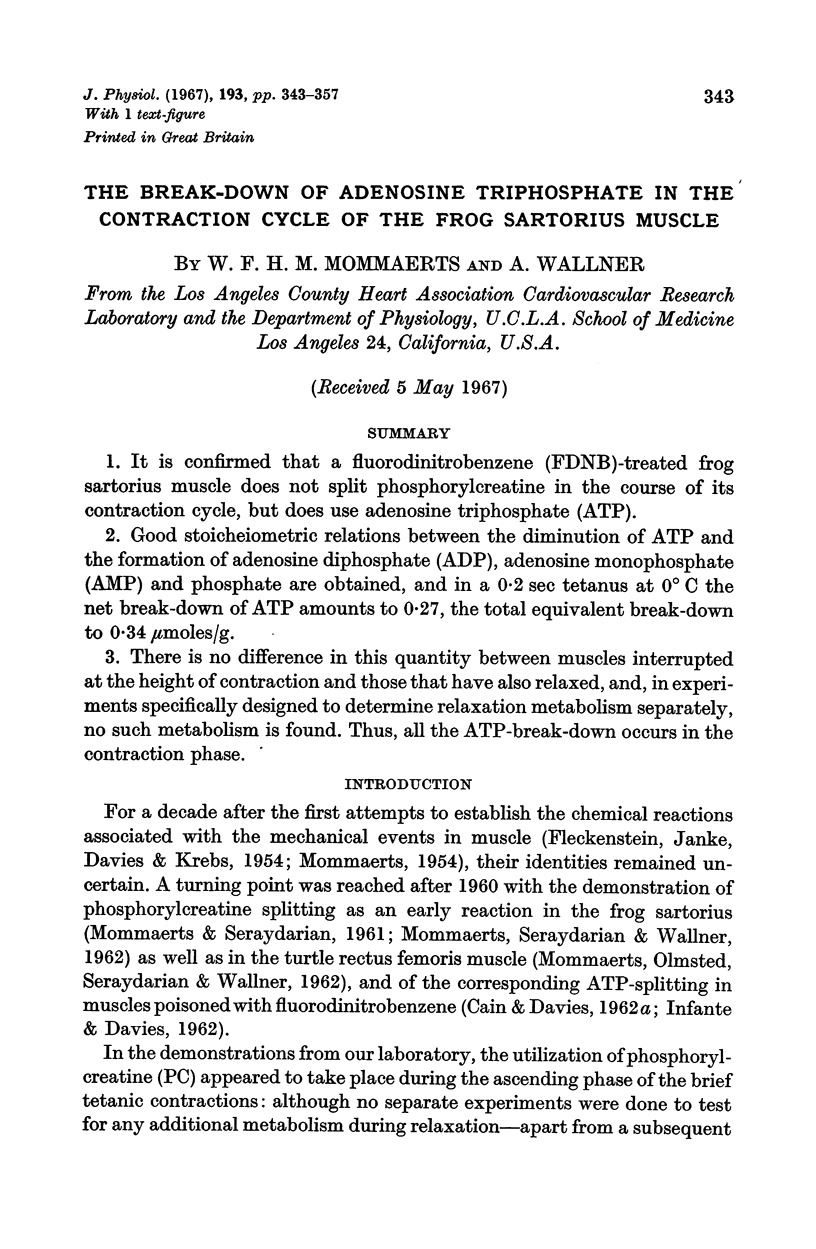
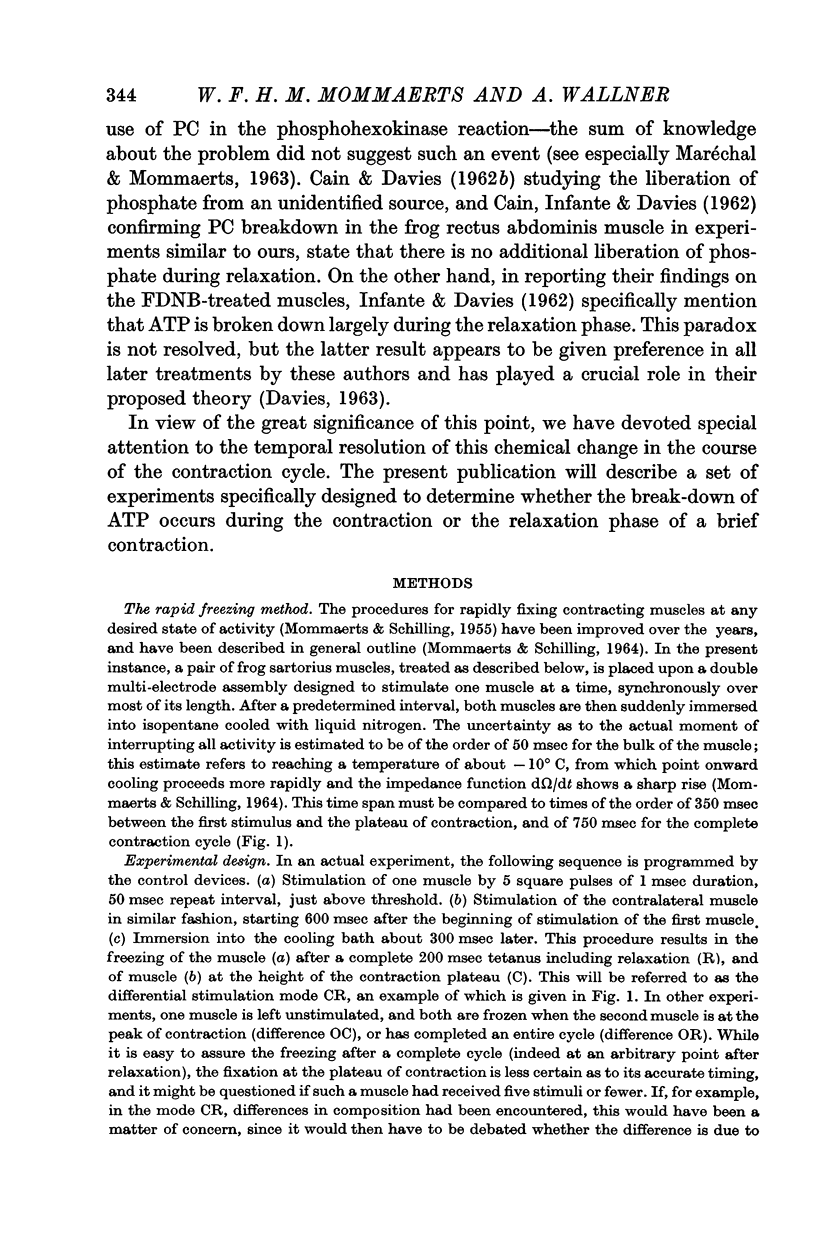
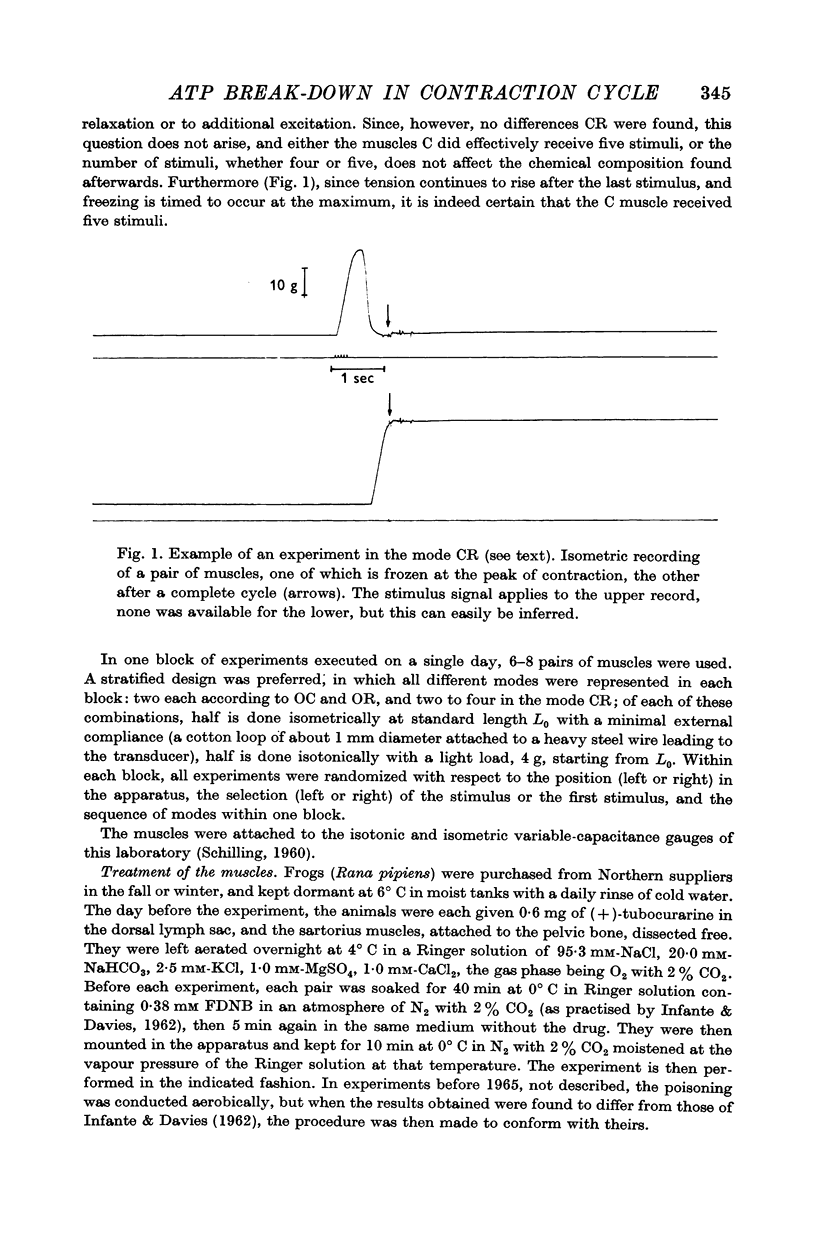
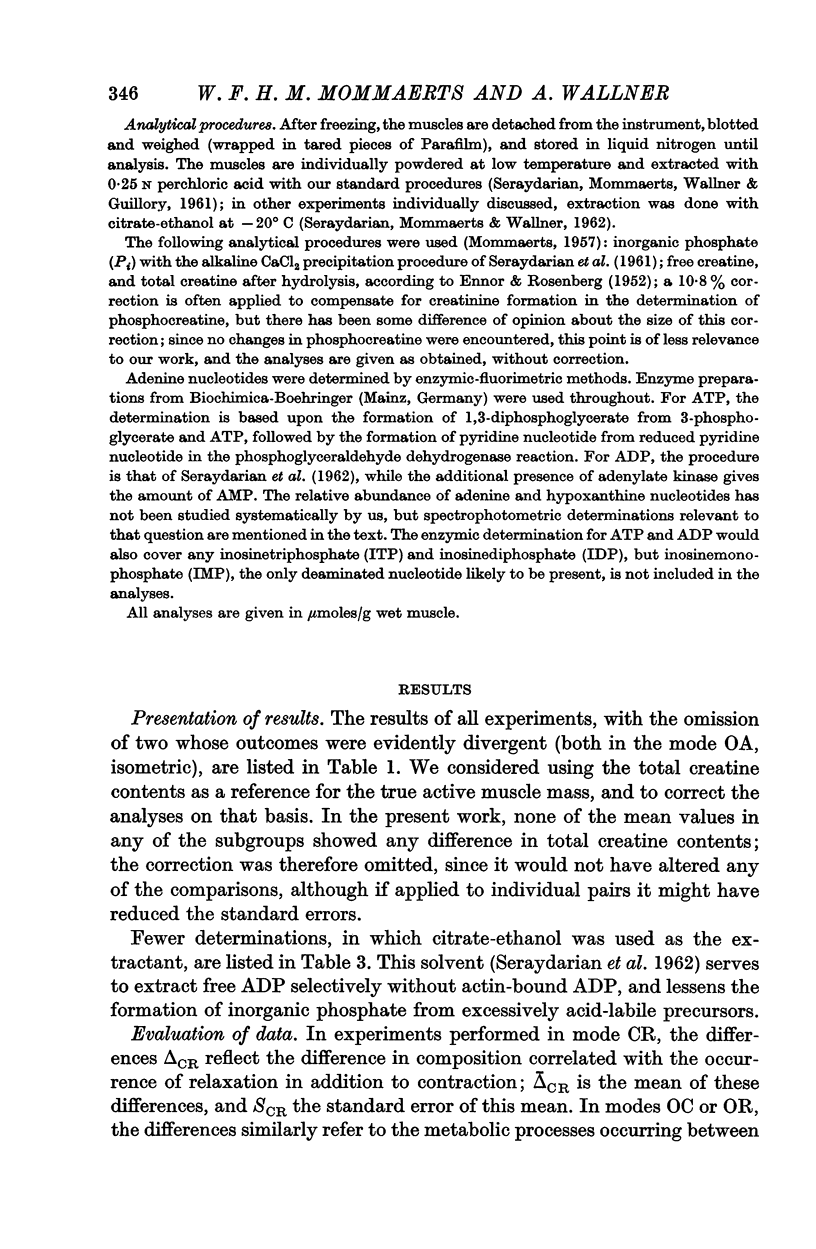
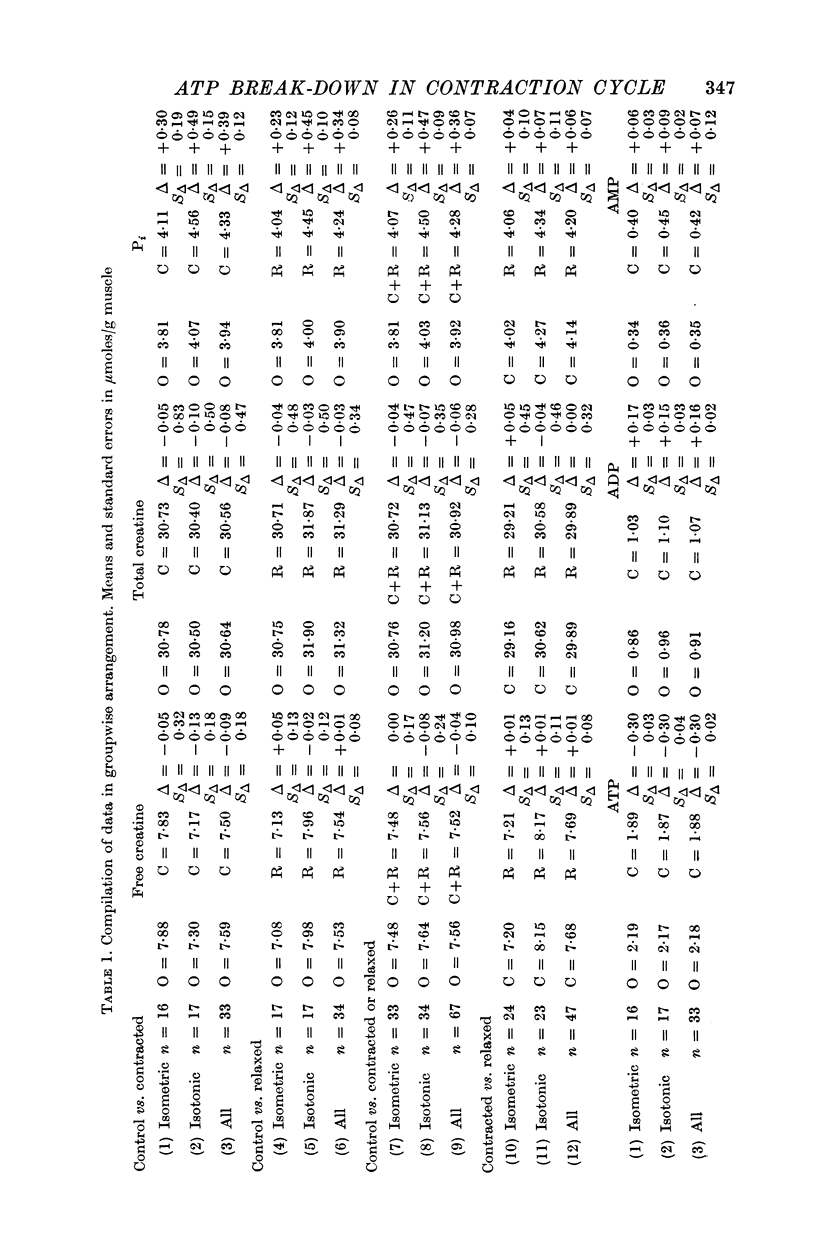
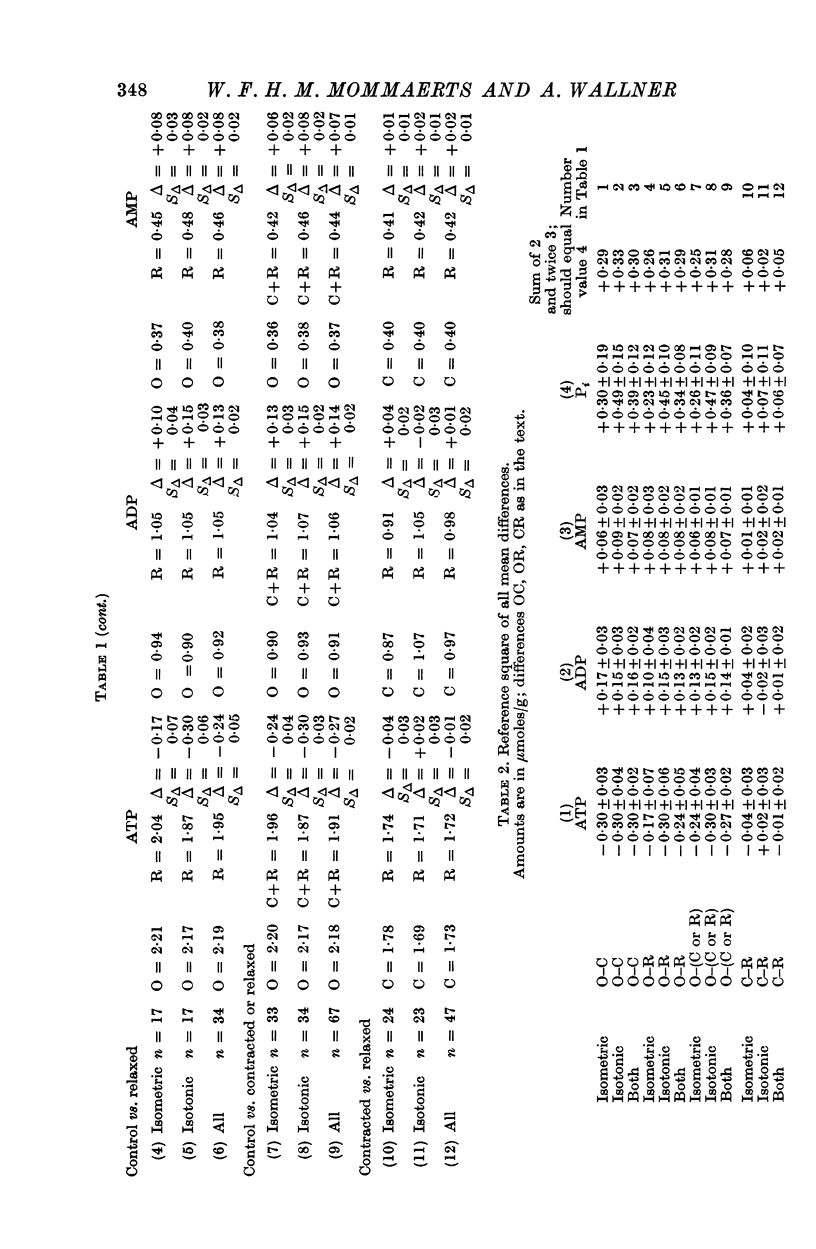
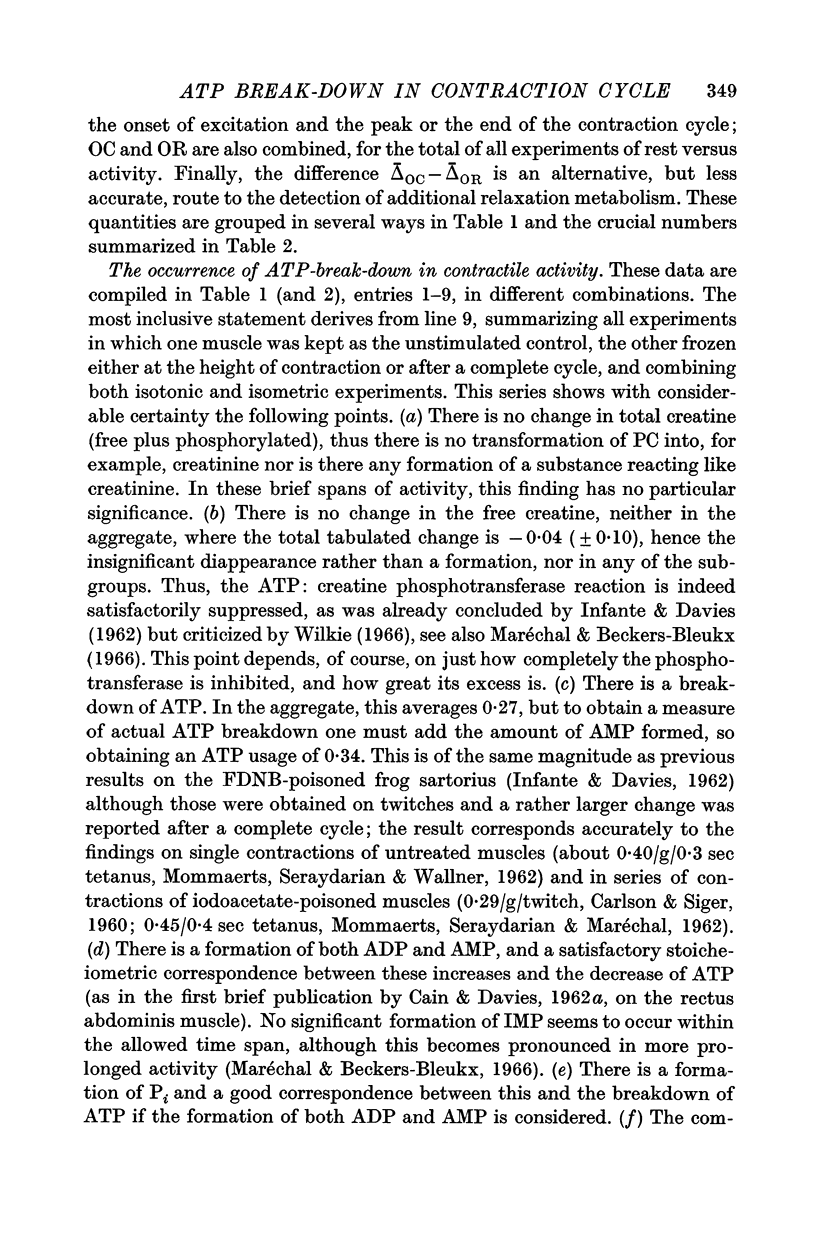
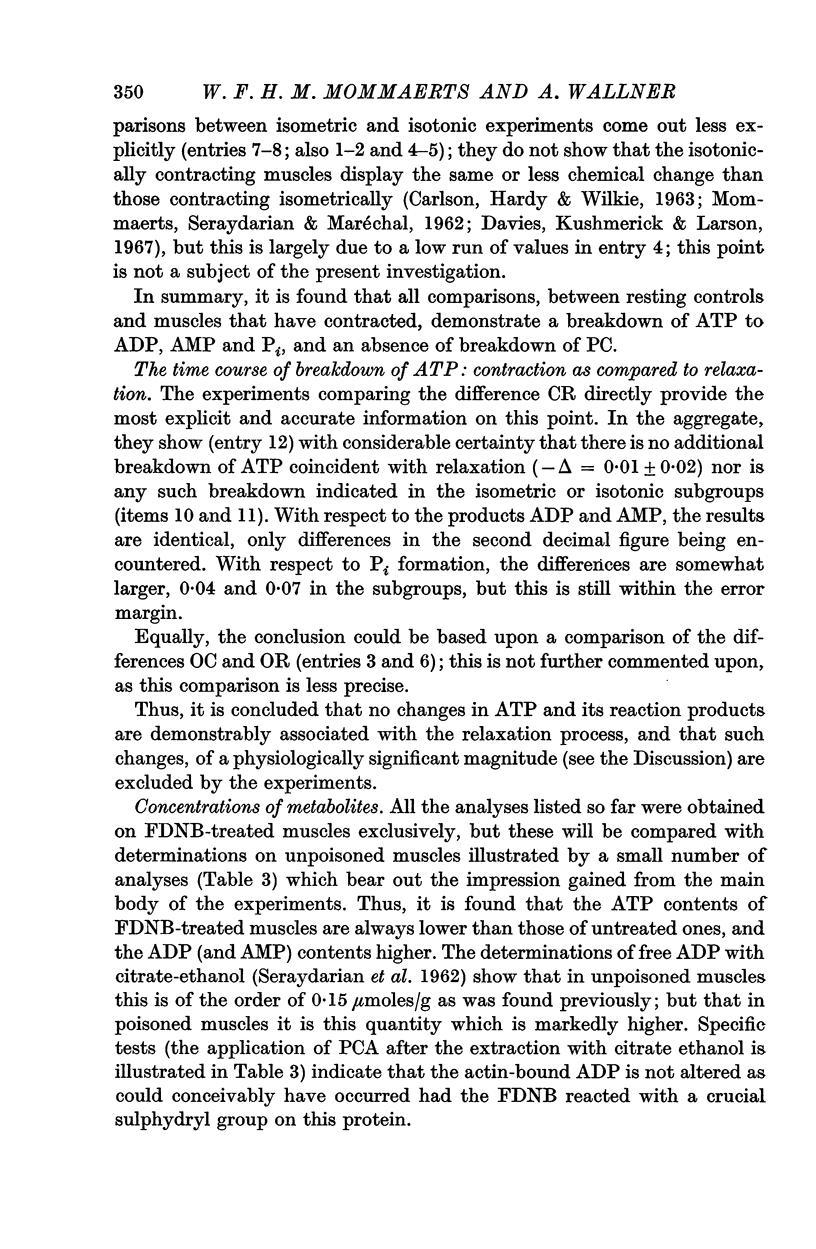
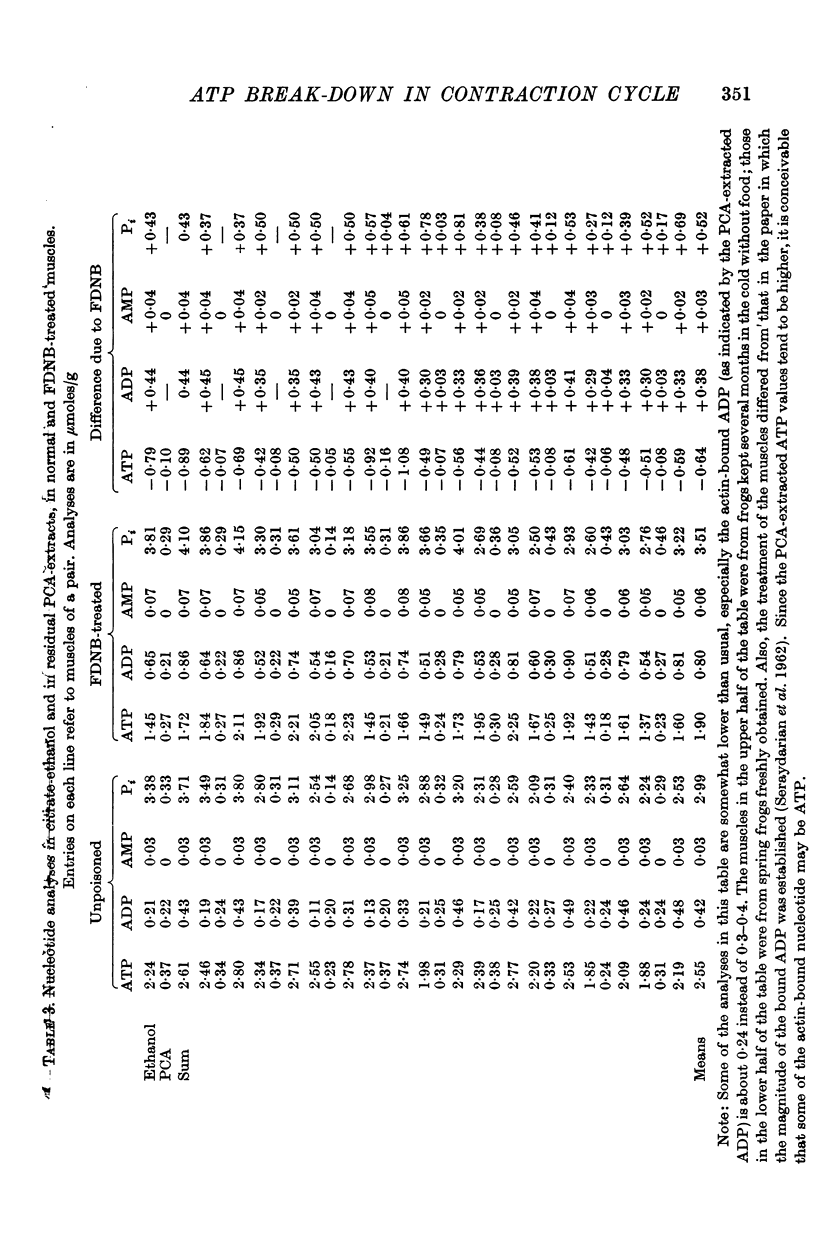
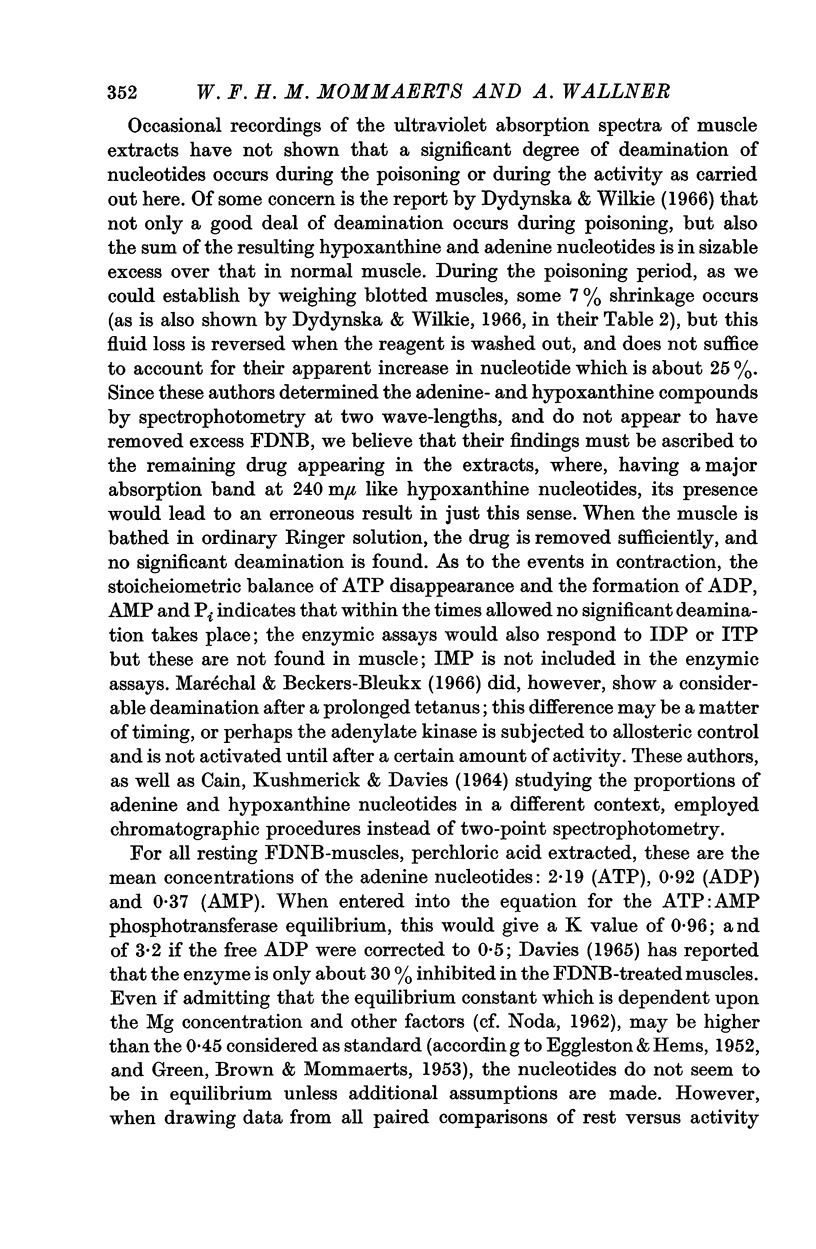
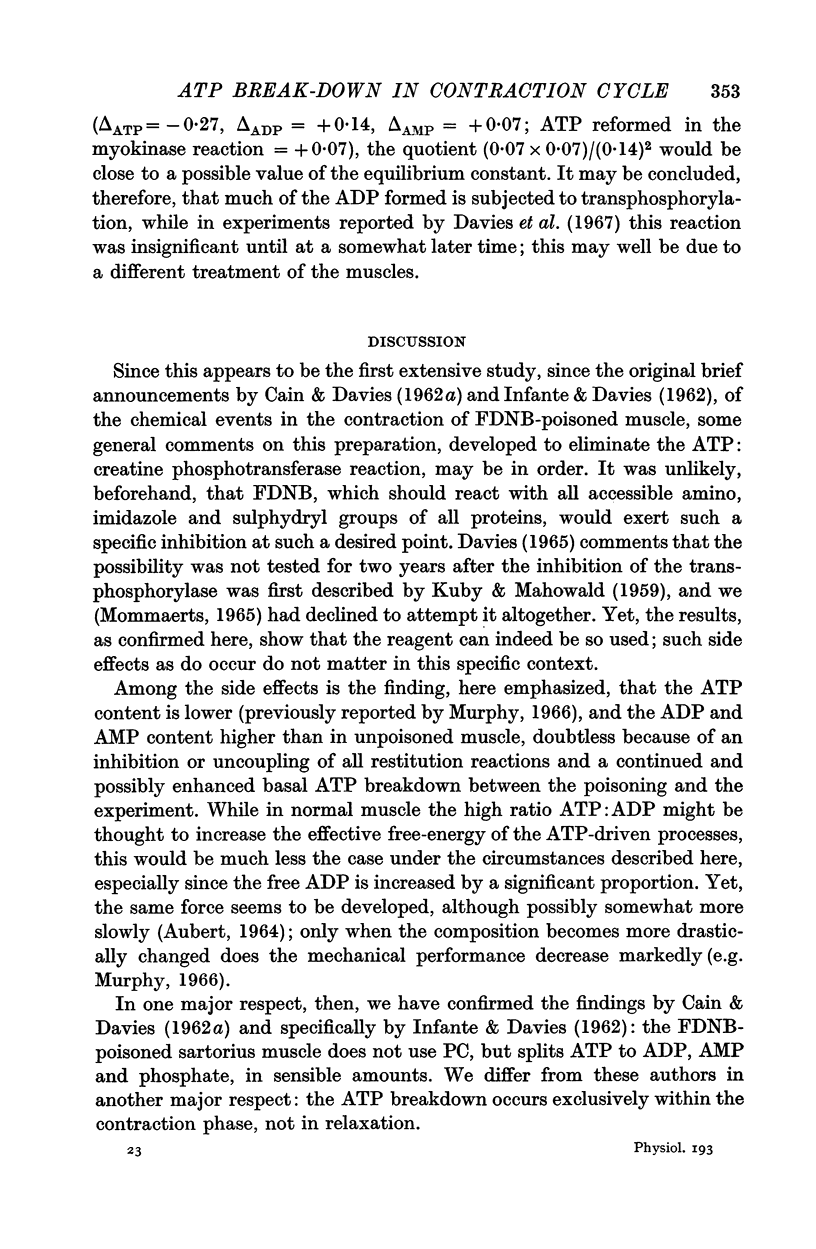
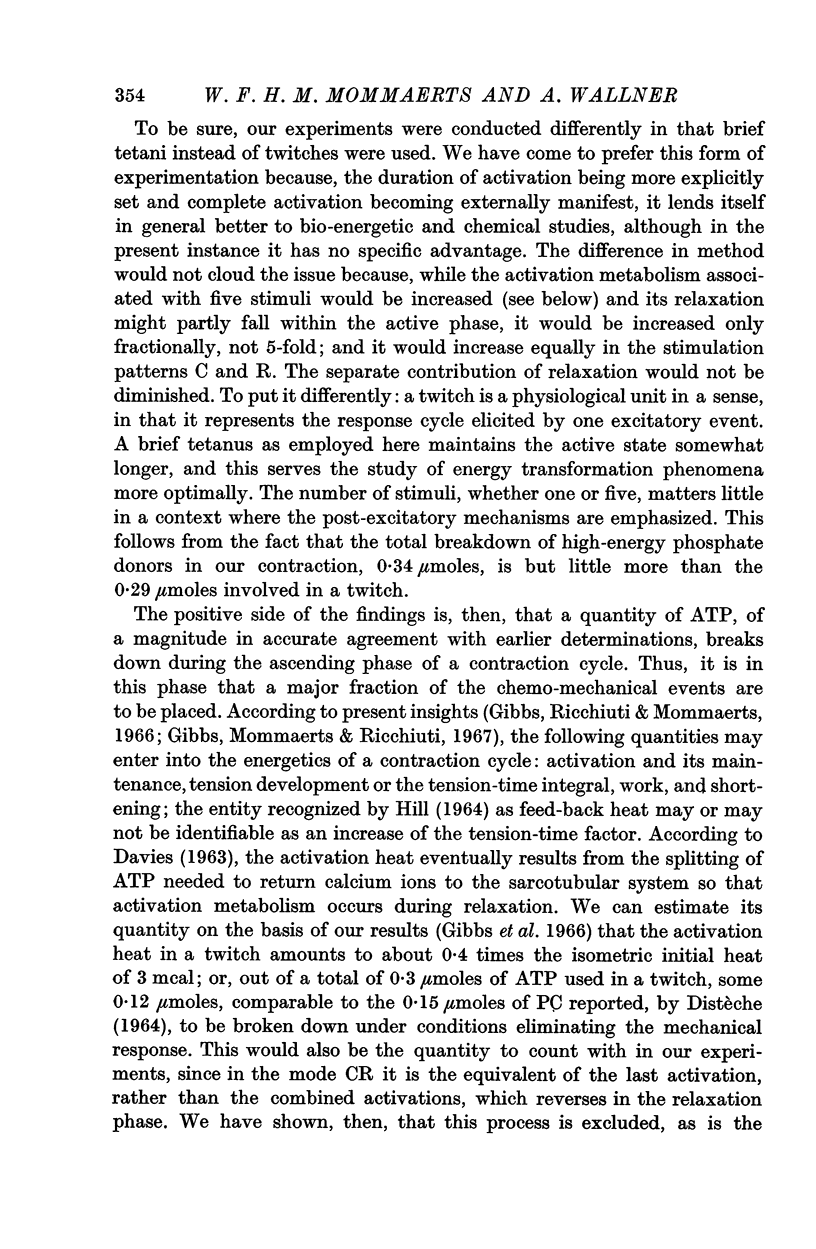
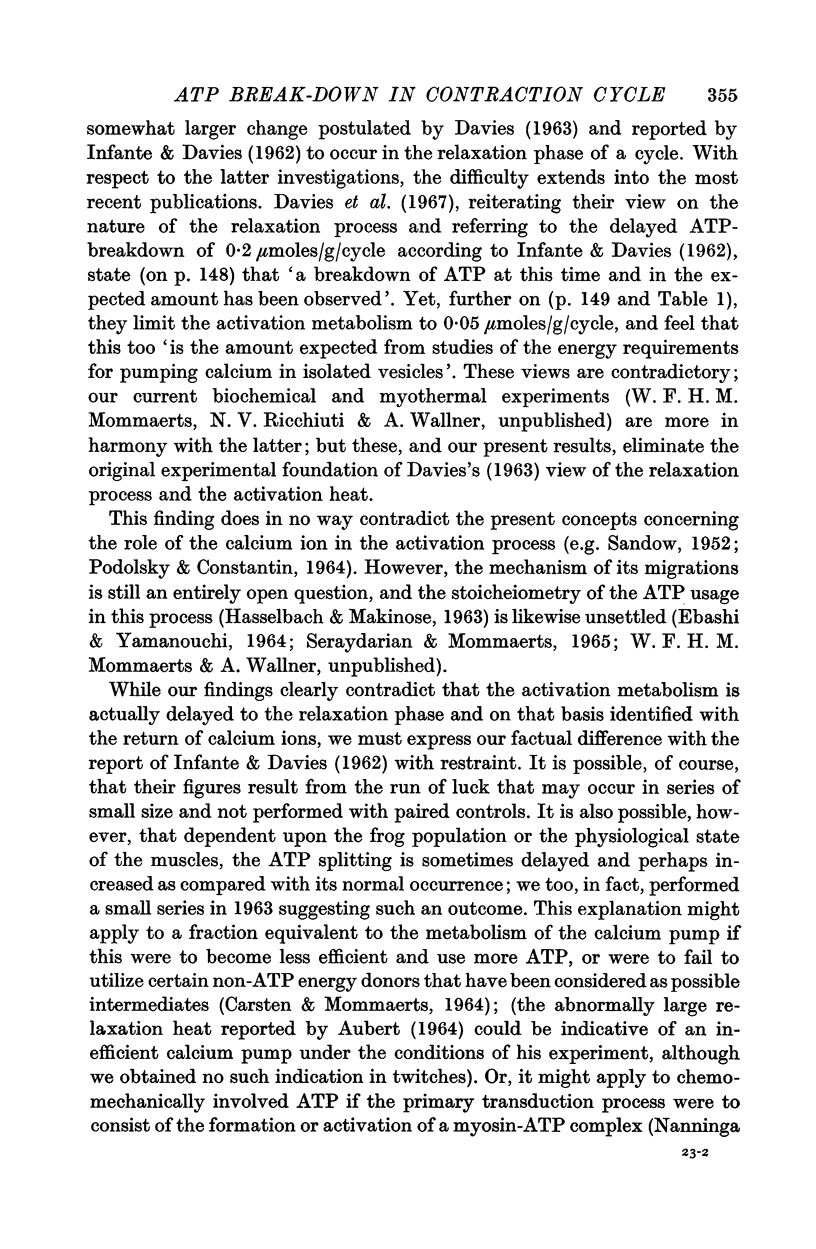
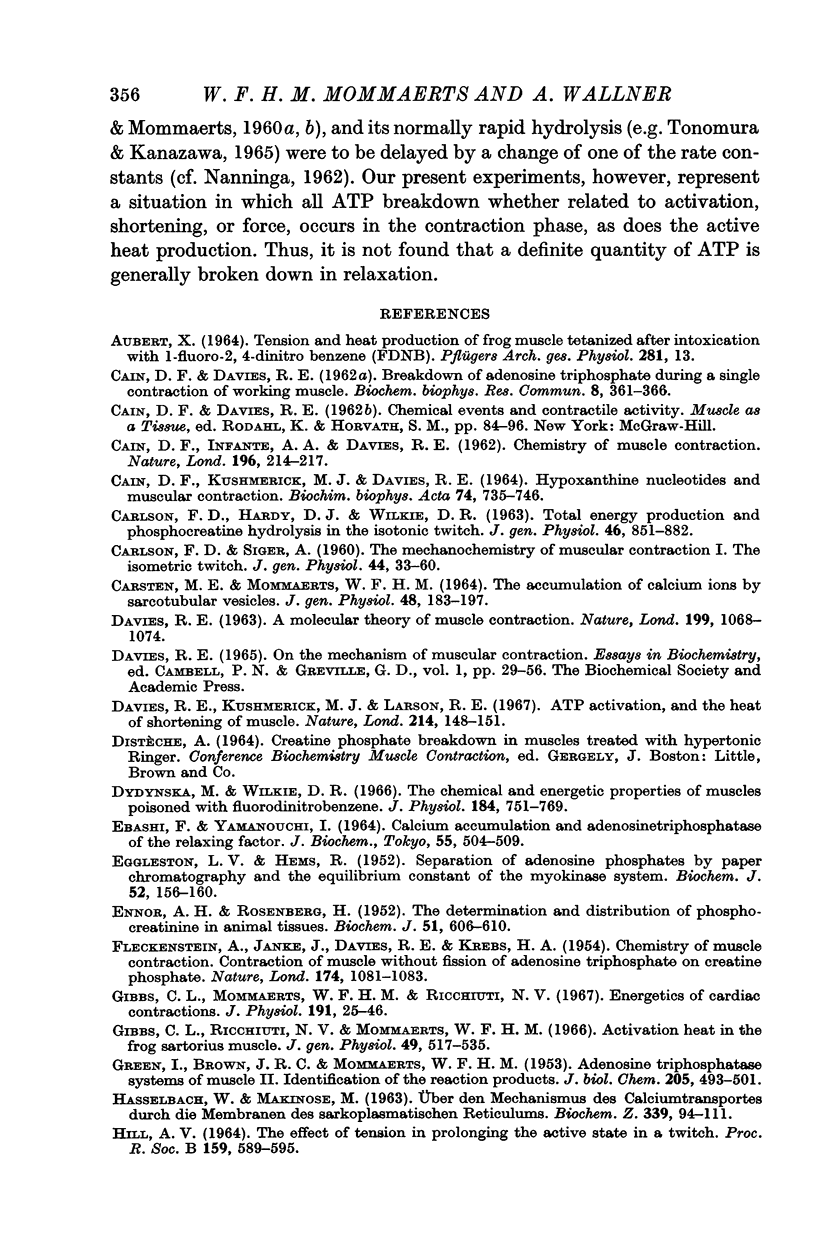
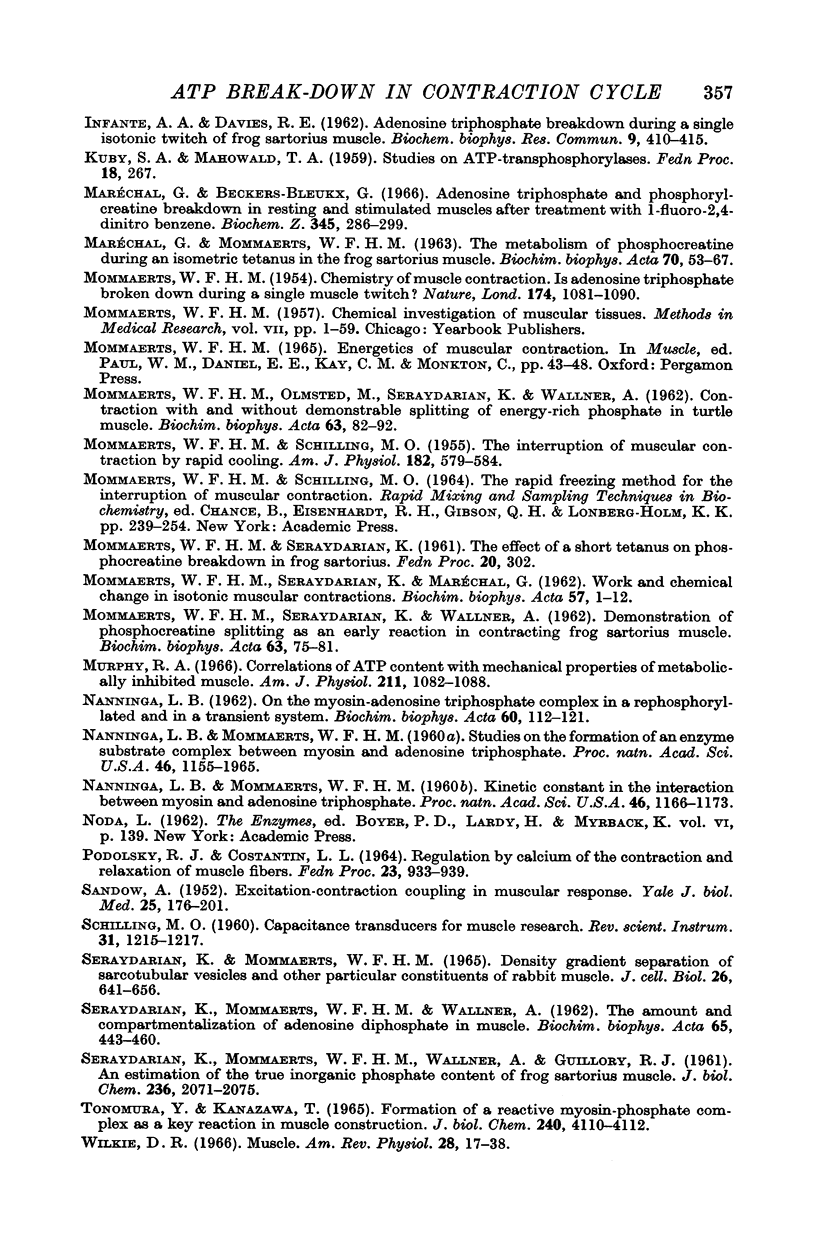
Selected References
These references are in PubMed. This may not be the complete list of references from this article.
- CAIN D. F., DAVIES R. E. Breakdown of adenosine triphosphate during a single contraction of working muscle. Biochem Biophys Res Commun. 1962 Aug 7;8:361–366. doi: 10.1016/0006-291x(62)90008-6. [DOI] [PubMed] [Google Scholar]
- CAIN D. F., INFANTE A. A., DAVIES R. E. Chemistry of muscle contraction. Adenosine triphosphate and phosphorylcreatine as energy supplies for single contractions of working muscle. Nature. 1962 Oct 20;196:214–217. doi: 10.1038/196214a0. [DOI] [PubMed] [Google Scholar]
- CAIN D. F., KUSHMERICK M. J., DAVIES R. E. HYPOXANTHINE NUCLEOTIDES AND MUSCULAR CONTRACTION. Biochim Biophys Acta. 1963 Sep 10;74:735–746. doi: 10.1016/0006-3002(63)91425-2. [DOI] [PubMed] [Google Scholar]
- CARLSON F. D., HARDY D. J., WILKIE D. R. Total energy production and phosphocreatine hydrolysis in the isotonic twitch. J Gen Physiol. 1963 May;46:851–882. doi: 10.1085/jgp.46.5.851. [DOI] [PMC free article] [PubMed] [Google Scholar]
- CARLSON F. D., SIGER A. The mechanochemistry of muscular contraction. I. The isometric twitch. J Gen Physiol. 1960 Sep;44:33–60. doi: 10.1085/jgp.44.1.33. [DOI] [PMC free article] [PubMed] [Google Scholar]
- CARSTEN M. E., MOMMAERTS W. F. THE ACCUMULATION OF CALCIUM IONS BY SARCOTUBULAR VESICLES. J Gen Physiol. 1964 Nov;48:183–197. doi: 10.1085/jgp.48.2.183. [DOI] [PMC free article] [PubMed] [Google Scholar]
- DAVIES R. E. A MOLECULAR THEORY OF MUSCLE CONTRACTION: CALCIUM-DEPENDENT CONTRACTIONS WITH HYDROGEN BOND FORMATION PLUS ATP-DEPENDENT EXTENSIONS OF PART OF THE MYOSIN-ACTIN CROSS-BRIDGES. Nature. 1963 Sep 14;199:1068–1074. doi: 10.1038/1991068a0. [DOI] [PubMed] [Google Scholar]
- Davies R. E., Kushmerick M. J., Larson R. E. ATP, activation, and the heat of shortening of muscle. Nature. 1967 Apr 8;214(5084):148–151. doi: 10.1038/214148a0. [DOI] [PubMed] [Google Scholar]
- Dydyńska M., Wilkie D. R. The chemical and energetic properties of muscles poisoned with fluorodinitrobenzene. J Physiol. 1966 Jun;184(3):751–769. doi: 10.1113/jphysiol.1966.sp007946. [DOI] [PMC free article] [PubMed] [Google Scholar]
- EBASHI F., YAMANOUCHI I. CALCIUM ACCUMULATION AND ADENOSINETRIPHOSPHATASE OF THE RELAXING FACTOR. J Biochem. 1964 May;55:504–509. [PubMed] [Google Scholar]
- EGGLESTON L. V., HEMS R. Separation of adenosine phosphates by paper chromotography and the equilibrium constant of the myokinase system. Biochem J. 1952 Sep;52(1):156–160. doi: 10.1042/bj0520156. [DOI] [PMC free article] [PubMed] [Google Scholar]
- ENNOR A. H., ROSENBERG H. The determination and distribution of phosphocreatine in animal tissues. Biochem J. 1952 Aug;51(5):606–610. doi: 10.1042/bj0510606. [DOI] [PMC free article] [PubMed] [Google Scholar]
- FLECKENSTEIN A., JANKE J., DAVIES R. E., KREBS H. A. Chemistry of muscle contraction; contraction of muscle without fission of adenosine triphosphate or creatine phosphate. Nature. 1954 Dec 11;174(4441):1081–1083. doi: 10.1038/1741081a0. [DOI] [PubMed] [Google Scholar]
- FLECKENSTEIN A., JANKE J., DAVIES R. E., KREBS H. A. Chemistry of muscle contraction; contraction of muscle without fission of adenosine triphosphate or creatine phosphate. Nature. 1954 Dec 11;174(4441):1081–1083. doi: 10.1038/1741081a0. [DOI] [PubMed] [Google Scholar]
- GREEN I., BROWN J. R., MOMMAERTS W. F. Adenosinetriphosphatase systems of muscle. II. Identification of the reaction products. J Biol Chem. 1953 Nov;205(1):493–501. [PubMed] [Google Scholar]
- Gibbs C. L., Mommaerts W. F., Ricchiuti N. V. Energetics of cardiac contractions. J Physiol. 1967 Jul;191(1):25–46. doi: 10.1113/jphysiol.1967.sp008235. [DOI] [PMC free article] [PubMed] [Google Scholar]
- Gibbs C. L., Ricchiuti N. V., Mommaerts W. F. Activation heat in frog sartorius muscle. J Gen Physiol. 1966 Jan;49(3):517–535. doi: 10.1085/jgp.49.3.517. [DOI] [PMC free article] [PubMed] [Google Scholar]
- HASSELBACH W., MAKINOSE M. UBER DEN MECHANISMUS DES CALCIUMTRANSPORTES DURCH DIE MEMBRANEN DES SARKOPLASMATISCHEN RETICULUMS. Biochem Z. 1963 Oct 14;339:94–111. [PubMed] [Google Scholar]
- INFANTE A. A., DAVIES R. E. Adenosine triphosphate breakdown during a single isotonic twitch of frog sartorius muscle. Biochem Biophys Res Commun. 1962 Nov 27;9:410–415. doi: 10.1016/0006-291x(62)90025-6. [DOI] [PubMed] [Google Scholar]
- MARECHAL G., MOMMAERTS W. F. The metabolism of phosphocreatine during an isometric tetanus in the frog sartorius muscle. Biochim Biophys Acta. 1963 Feb 19;70:53–67. doi: 10.1016/0006-3002(63)90718-2. [DOI] [PubMed] [Google Scholar]
- MOMMAERTS W. F., OLMSTED M., SERAYDARIAN K., WALLNER A. Contraction with and without demonstrable splitting of energy-rich phosphate in turtle muscle. Biochim Biophys Acta. 1962 Sep 10;63:82–92. doi: 10.1016/0006-3002(62)90340-2. [DOI] [PubMed] [Google Scholar]
- MOMMAERTS W. F., SCHILLING M. O. Interruption of muscular contraction by rapid cooling. Am J Physiol. 1955 Sep;182(3):579–584. doi: 10.1152/ajplegacy.1955.182.3.579. [DOI] [PubMed] [Google Scholar]
- MOMMAERTS W. F., SERAYDARIAN K., MARECHAL G. Work and chemical change in isotonic muscular contractions. Biochim Biophys Acta. 1962 Feb 12;57:1–12. doi: 10.1016/0006-3002(62)91071-5. [DOI] [PubMed] [Google Scholar]
- MOMMAERTS W. F., SERAYDARIAN K., WALLNER A. Demonstration of phosphocreatine splitting as early reaction in contracting frog sartorius muscle. Biochim Biophys Acta. 1962 Sep 10;63:75–81. doi: 10.1016/0006-3002(62)90339-6. [DOI] [PubMed] [Google Scholar]
- Murphy R. A. Correlations of ATP content with mechanical properties of metabolically inhibited muscle. Am J Physiol. 1966 Nov;211(5):1082–1088. doi: 10.1152/ajplegacy.1966.211.5.1082. [DOI] [PubMed] [Google Scholar]
- NANNINGA L. B. On the myosin-adenosinetriphosphate complex in a rephosphorylated and in a transient system. Biochim Biophys Acta. 1962 Jun 18;60:112–121. doi: 10.1016/0006-3002(62)90378-5. [DOI] [PubMed] [Google Scholar]
- Nanninga L. B., Mommaerts W. F. KINETIC CONSTANTS OF THE INTERACTION BETWEEN MYOSIN AND ADENOSINETRIPHOSPHATE. Proc Natl Acad Sci U S A. 1960 Aug;46(8):1166–1173. doi: 10.1073/pnas.46.8.1166. [DOI] [PMC free article] [PubMed] [Google Scholar]
- Nanninga L. B., Mommaerts W. F. STUDIES ON THE FORMATION OF AN ENZYME-SUBSTRATE COMPLEX BETWEEN MYOSIN AND ADENOSINETRIPHOSPHATE. Proc Natl Acad Sci U S A. 1960 Aug;46(8):1155–1166. doi: 10.1073/pnas.46.8.1155. [DOI] [PMC free article] [PubMed] [Google Scholar]
- PODOLSKY R. J., COSTANTIN L. L. REGULATION BY CALCIUM OF THE CONTRACTION AND RELAXATION OF MUSCLE FIBERS. Fed Proc. 1964 Sep-Oct;23:933–939. [PubMed] [Google Scholar]
- SANDOW A. Excitation-contraction coupling in muscular response. Yale J Biol Med. 1952 Dec;25(3):176–201. [PMC free article] [PubMed] [Google Scholar]
- SERAYDARIAN K., MOMMAERTS W. F., WALLNER A., GUILLORY R. J. An estimation of the true inorganic phosphate content of frog sartorius muscle. J Biol Chem. 1961 Jul;236:2071–2075. [PubMed] [Google Scholar]
- SERAYDARIAN K., MOMMAERTS W. F., WALLNER A. The amount and compartmentalization of adenosine diphosphate in muscle. Biochim Biophys Acta. 1962 Dec 17;65:443–460. doi: 10.1016/0006-3002(62)90447-x. [DOI] [PubMed] [Google Scholar]
- Seraydarian K., Mommaerts W. F. Density gradient separation of sarcotubular vesicles and other particulate constituents of rabbit muscle. J Cell Biol. 1965 Aug;26(2):641–656. doi: 10.1083/jcb.26.2.641. [DOI] [PMC free article] [PubMed] [Google Scholar]
- Tonomura Y., Kanazawa T. Formation of a reactive myosin-phosphate complex as a key reaction in muscle contraction. J Biol Chem. 1965 Oct;240(10):4110–4112. [PubMed] [Google Scholar]


